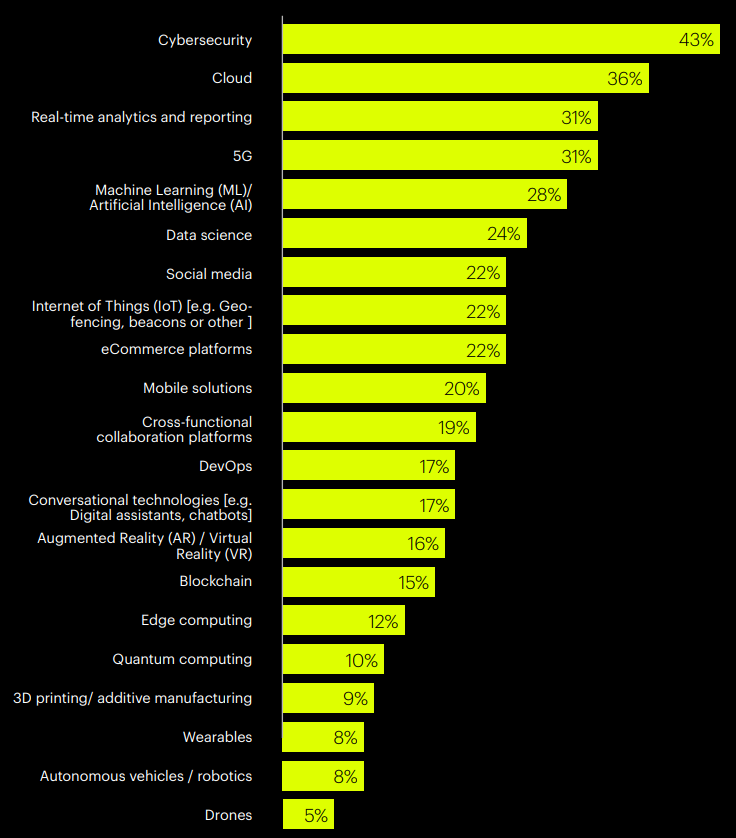In this fast-paced 21st century, every company feels the need to go through the digital transformation process while some organizations still struggle to advance this. To survive and thrive, leaders should determine how to maintain a competitive advantage and succeed in a world of constant change while embracing it to create a new strategy.
This blog will suggest some future investment and key insight to help you navigate the challenges and reap the benefits that come with digital transformation. This is the final part of our 2021 report on the digital transformation stage. Please check out the first, second, and third part of the series before starting this fourth part. If you have read all the previous parts, let’s get started!
Table of Contents
Top priorities for technology investments in 2021-2022
Following several cyberattacks and data breaches, organizations can no longer afford to be careless with their data and infrastructure. As firms use and keep more customer data, cybersecurity has become a primary responsibility for IT departments. In fact, Cloud applications have maintained their position as a top investment, since more software is moved to SaaS platforms and corporations continue to relocate their data storage to giant cloud providers such as Amazon, Microsoft, and Google, among others.
According to the board, companies are also showing their sustained focus on leveraging data to create insights with significant investments in real-time analytics, machine learning, and data science.
Top priorities for your next phase of digital transformation
According to survey findings, modernizing information technology (IT) is a top objective for all businesses (40%), even the digital transformation shift into the next phase. This demonstrates that organizations continue to consider technology improvements as well as continual and important for responding to any form of industry or digital upheaval.
On the other hand, this figure highlights the difference between top performers and average performers in the initiatives is that they are emphasizing the future. Individuals who perform at or above-average levels are more likely to place a high value on artificial intelligence (AI), personalization, and improving the digital customer experience. In this case, these are initiatives that high performers had emphasized much earlier in their careers and which are currently operating at a high level of maturity.
When we analyze the priorities of top performers, we can also gain insight into the next phase of digital transformation. Clearly, Product innovation and better data storage and access are two of the top priorities for the company. Furthermore, while it is not yet a top priority, top performers are more likely than average organizations to invest in external alliances or ecosystems for the purpose of reciprocal value exchange.
Interestingly, This also suggests that the next phase of transformation will be characterized by even more use of data in the service of experience and creativity, as well as more outward-looking efforts such as partnerships and platform ecosystems to produce even more new value and innovative practices.
Key insight
Based on the report and our analysis, we can recommend that companies should invest in the following areas, regardless of their levels of maturity in order to thrive in the next phase of digital transformation.
Transforming with a specific goal
Another key insight from the report is that transformation simply for the sake of transformation does not succeed in the long run. At the very least, it produces average results. When a company changes only to stay up with the times, it will constantly be in the process of keeping up with the times. Due to the rapidity with which innovation is occurring today, they will be forever one step behind.
What we discovered instead was that transformation that has a clear, forward-thinking aim, such as growth, innovation, or reinvention, is significantly more likely to be successful than transformation that does not. Because of the importance of having a single purpose, it is easier to coordinate activities across numerous teams and functions, and it is also more compelling for employees who are resistant to change. This is why it is critical for the CEO to drive transformation efforts, as they are ultimately responsible for the company’s vision and purpose. None of the company’s other executives possess the same level of credibility and access to resources that are necessary for the creation and socialization of a shared purpose for the organization.
Customer and employee satisfaction are top priorities.
Typical companies focused on technological infrastructure and processes. Successful businesses have harnessed their attention to technology in the service of providing excellent experiences for both consumers and staff. Customers also benefited from this by having access to more relevant content, more tailored messages, and more efficient digital workflows.
Interestingly, employees now have greater tools to communicate and be more productive as a result of these advancements. Following the COVID-19 epidemic, these investments have yielded exponential returns, leaving these organizations better poised for the next phase of transformation.
Developing data as strategic asset
The report highlighted a significant difference between how successful organizations use data and everyone else. These companies took proactive steps to establish a leadership position in data management and developed a clear strategy for accessing, storing, and leveraging the information they required. They’ve also developed methods by which data from many sources may be merged into a single platform, with insights made available to multiple portions of the company.
In addition, by using artificial intelligence and machine learning technology, these companies may gain insights faster and more efficiently than they have ever before. Using digital data in this manner allows them to create personalized experiences for customers as well as innovate products and business models, amongst other things. It’s safe to say that, no matter what the next phase of transformation brings, the winners will be characterized by the power of their data skills, regardless of the circumstances.
Identifying and adapting to the convergence of technologies
We’ve observed a growing convergence of company functions, especially customer-facing ones like sales, service, and marketing. Companies that are more established are now preparing for external convergence. The growth of digital communications and the ease with which data can be shared has enabled firms to move beyond their old business models and value propositions and embrace a converging ecosystem of apps, partners, and platforms that generates mutual value for all parties.
For example, imagine credit card firms collaborating with hotels in order to share consumer loyalty program information. It can also imply connecting to second-and third-party data networks in order to obtain access to new data sources. The best way to prepare for convergence is to have a robust foundation for data management, as well as an in-depth understanding of the client base, as the result, businesses are able to meet them wherever they are rather than being restricted to owned channels.
Innovating as a business strategy
It wasn’t enough for top achievers to be transformed; they also needed to be innovative. Many of these top-performing firms evaluated the effectiveness of their transformation by the use of innovation-focused measures, as the number of pilot programs completed, proof of concepts completed, and new ideas developed. Successful firms have a formalized, continuous focus on innovation. For them, financial successes were not enough; they had to keep showing a desire to progress and embrace the new and creative. Businesses that have innovated will be able to adapt and thrive in the face of industry shifts and new technologies.
In conclusion
An adaptive business in the 21st century is typically a digitally powered business. If your organization’s strategies are facing pressing issues, such as growth and innovation, talent and technology, and risk, Magenest will be a valuable resource for organizations of all sizes. As part of our mission to provide clients with benefits while also promoting sustainable growth, Magenest will help companies in their digital transformation efforts and in helping their workers adjust to technological advancements. Contact us now!














